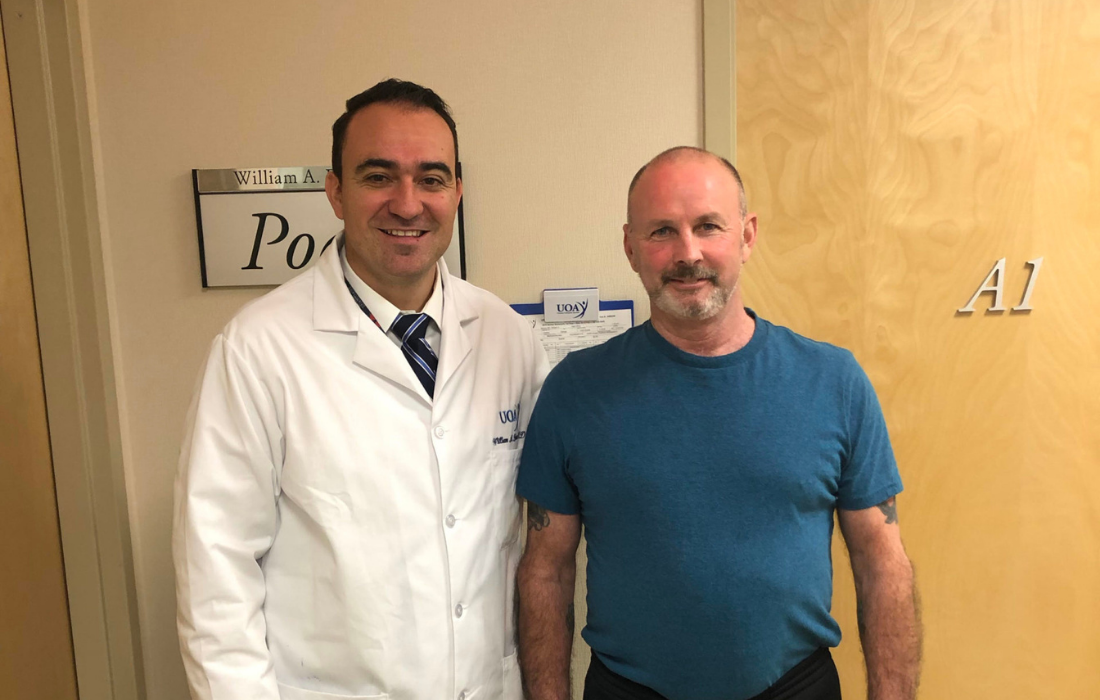What Is a Hip Replacement?
Hip replacement surgery is a treatment option for people with severe hip joint damage, usually from osteoarthritis. Hip replacement surgery removes damaged bone and cartilage of the hip joint and replaces them with new prosthetic (artificial) parts. Hip replacement seeks to relieve pain and improve walking and other hip joint movements overall.
Hip replacement surgery was first performed in 1960. Since then, improvements in joint replacement technology and techniques have improved the safety and effectiveness of total hip replacement. Hip replacement is one of the most common surgical procedures in the U.S. with nearly 500,000 total hip replacements performed each year.
Anatomy of the Hip Joint
The hip is a ball-and-socket type joint and is one of the body’s largest joints. The ball is the upper end of the thighbone (femur, femoral head) and the socket is formed by part of the pelvis bone (acetabulum).
The surfaces of these bones are covered with smooth articular cartilage, enabling them to move easily. A thin synovial membrane surrounds the joint, which produces lubricating fluid for the cartilage and eliminates hip movement friction. Ligaments provide stability by connecting the ball to the socket.
Types of Hip Replacement Surgery
Hip replacement surgery may be performed from behind the hip (posterior approach), to the side of the hip (lateral approach) or from in front of the hip (anterior approach). Total hip replacement (also called total hip arthroplasty) involves cutting away damaged bone and cartilage and replacing the joint with prosthetic components. Posterior and lateral approaches are considered traditional hip replacement surgery that involve a long incision to view the entire joint.
Total hip replacement using the anterior approach refers to surgeries performed from the front of the hip. Other names for this surgery are mini, modified, minimally invasive or muscle-sparing surgeries. The biggest reason for selecting an anterior approach is a reduced recovery time, about half that of traditional hip replacement.
The anterior approach uses one incision and typically has a shorter hospital stay—one to two days in some cases, and same-day outpatient in others. Traditional approaches, on the other hand, can require a hospital stay of up to four days. The decision for which surgery is performed is based on individual patient factors.
Sometimes, both hip joints need replacement. UOA joint replacement physicians will advocate a simultaneous bilateral hip replacement for certain patients. The benefits include less overall hospital time, only one time spent under anesthesia and less overall rehabilitation time. Using an anterior approach, which results in less pain and disability, makes a bilateral hip replacement attractive to many patients who need both hips replaced.
Indications for Hip Replacement
Damage to the hip joint is the main indicator for hip replacement surgery. The hip joint may become damaged due to one or more factors, including:
- Arthritis
- Osteoarthritis (wear and tear) is the main cause of damage to the hip joint, causing pain, swelling and reduced joint motion.
- Rheumatoid arthritis may also cause damage by producing inflammation that erodes cartilage and occasionally underlying bone.
- Traumatic arthritis is a form of osteoarthritis that develops after an injury or fracture to the joint.
- Disease that causes the bone in joints to deteriorate or die, such as osteonecrosis, where blood flow to the joint is limited.
- Injuries or fractures, such as those common during a fall or traumatic event like a car accident
- Childhood hip disease
- Hip pain that limits everyday activities, such as walking, bending, going up or down stairs, or rising from a seated position
- Hip pain while resting (day or night), which may interfere with the ability to sleep
- Stiffness in a hip that impairs the ability to move or lift the leg
- Poor pain relief from nonsurgical treatments, such as anti-inflammatory pain medications
Contraindications to Hip Replacement Surgery
Though hip replacement surgery is a safe and effective procedure, there are still contraindications to hip surgery for some patients. Hip replacement surgery is not recommended in patients that have any of the following factors:
- Overall poor health
- High risk of infection
- Any disease that causes severe muscle weakness
- Nonamubulatory patients—those who have trouble moving or getting out of bed
Candidates for Hip Replacement
Before recommending hip surgery, other nonsurgical treatments to decrease hip pain and improve function are recommended, such as:
- Physical therapy
- Exercise program, often combined with physical therapy
- Walking aids, such as a cane
- Anti-inflammatory medications
If the pain remains and makes daily activities difficult to perform, an X-ray may be ordered to look for damage to the joint and the extent of the damage. If damage is present, a hip replacement may be suggested.
Recommendations for surgery are based on a patient’s level of pain and disability. Age is not a factor in the decision to perform hip surgery. Though people of ages 50 to 80 comprise most hip replacement surgeries, all patients are evaluated individually. Total hip replacements have been performed successfully at all ages, from the young to the elderly.
Hip Replacement Surgical Procedure
In traditional hip replacement surgery, an incision over the back or side of the hip is made through the layers of tissue. Diseased and damaged bone and cartilage are removed and healthy bone is left intact.
The prosthetic socket part of the joint is implanted in the pelvic bone. A prosthetic ball is then attached to a stem that fits into the hollow center of the femur. The stem may either be cemented or “press fit” into the femur depending on what works best with a patient’s individual anatomy and bone quality.
The damaged cartilage that covers the socket (acetabulum) is cut away and replaced with a titanium socket. Screws may be used to hold the new socket in place. A plastic or ceramic spacer is placed between the new ball and the socket, which provides a smooth gliding surface.
An anterior approach allows the surgeon to access the hip from the front through a single small incision. An anterior approach has a number of advantages, such as:
- Less trauma to surrounding muscles
- Less pain
- Quicker and easier recovery
- Shorter hospital stay
- Less disability
- Reduced chance of dislocation
Hip Replacement Recovery
Healthy, active people often have very good results after hip replacement surgery. People typically spend one to two days in the hospital after hip replacement surgery. It takes about three to six months to completely heal and up to 12 months to restore full strength. Our surgeons at UOA routinely perform same-day outpatient hip replacements in appropriately selected patients, with patients being able to leave the surgery center after a couple of hours in recovery.
Recovery from a total hip replacement using an anterior approach is typically much shorter than a traditional hip replacement. Most people are well on their way to complete recovery by six weeks.
Arranging for a smooth transition at home is helpful by making a few modifications, such as having meals prepared, moving higher and lower household objects to waist level to avoid bending or reaching up, and possibly getting a raised toilet seat. The doctor or nurse should provide a full list of helpful modifications.
The surgery’s success depends on how well the orthopaedic surgeon’s instructions regarding home care are followed during the first few weeks after surgery. Instructions will be given regarding wound care, diet and activity.
Walking is critical during recovery, especially during the first few weeks after surgery. Most normal light activities of daily living may be resumed within three to six weeks, though some discomfort may be present. Discomfort and stiffness at night is also common for several weeks.
An exercise program may be provided, which should include a graduated walking plan designed to slowly increase mobility, resuming normal daily home activities, and specific daily exercises to restore movement and strengthen the hip. A physical therapist is often a part of any exercise program.
Complications
While not frequent, hip dislocation can occur after surgery. Because an artificial hip is smaller than the original joint, the ball can come out of its socket easier than the natural joint. With a hip replacement, you might need to avoid certain activities such as jogging and high-impact sports to reduce risk of dislocating the hip.
Blood clots are a risk factor with this surgery. To prevent clots from forming, early movement after surgery is required, as well as blood thinning medication and pressure application, possibly from a compression stocking or inflatable air sleeve. Patients are provided with a list of what symptoms to watch for.
Final Results
A follow-up appointment with the surgeon is scheduled after surgery to be sure the hip is healing properly. For most people with proper healing, normal activities may be resumed by about 6 weeks, though possibly limited. Recovery with improving strength will continue to occur for 6 to 12 months.
Each patient heals at a different rate. Daily incremental improvement should not be the measure of healing. There will be ups and downs in the healing process. Instead, overall long-term improvement should be evaluated.
The new hip joint should reduce the pain felt before your surgery and increase the range of motion in the joint. Though the hip may be stronger and experience less pain, not all pre-surgical activities may be resumed. High-impact activities, such as running or playing basketball, may place too much stress on the new joint. Eventually, lower impact activities may be performed, such as swimming, golf, hiking or riding a bike.
If you are experiencing hip pain and think you may be a candidate for hip replacement, request an appointment with one of University Orthopaedic Associates’ joint replacement experts. We will carefully examine your hips and help you determine whether hip replacement is right for you.




